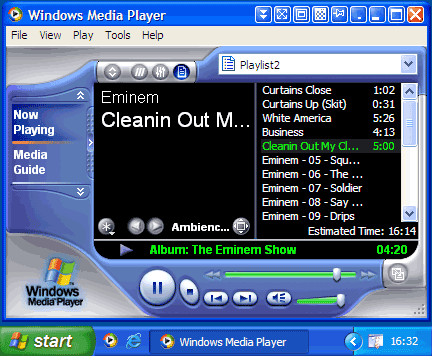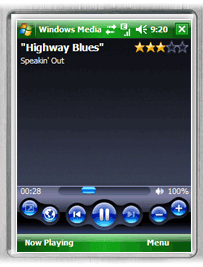Antivirus Avg Antivirus McAfee Antivirus Norton Antivirus Ad-Aware Antivirus Avast Antivirus Messangers Yahoo Messanger Msn Messanger GoogleTalk Messanger Aol Messanger mIRC Messanger Multimedia JetAudio RealPlayer Winamp Player Media Player The KM player |
Windows Media Player (WMP) is a digital media player and media library application developed by Microsoft that is used for playing audio, video and viewing images on personal computers running the Microsoft Windows operating system, as well as on Pocket PC and Windows Mobile-based devices. Editions of Windows Media Player were also released for Mac OS, Mac OS X and Solaris but development of these has since been discontinued. In addition to being a media player, Windows Media Player includes the ability to rip music from and copy music to compact discs, build Audio CDs in recordable discs and synchronize content with a digital audio player (MP3 player) or other mobile devices, and enables users to purchase or rent music from a number of online music stores. Windows Media Player replaced an earlier piece of software simply called Media Player, adding features beyond simple video or audio playback. History Features
Windows has had a media player since the year 1991, when Windows 3.0 with MultiMedia Extensions was released. The original Media Player application used MCI to handle media files. In 1996 Microsoft released ActiveMovie, a new way of dealing with media files and streaming media (which the original Media Player couldn't handle). A wrapper was provided for users in the form of the ActiveMovie Control, allowing users to play media files on their computer.
 Windows Mobile
Windows Media Player for Pocket PC was first announced on January 6, 2000, and has been revised on a schedule roughly similar to that of the Windows version.Currently known as "Media Player 10 Mobile", this edition (released in October 2004) closely resembles the capabilities of the Windows version of WMP 10, including playlist capabilities, a media library, album art, WMA Lossless playback, support for DRM-protected media, video playback at 640x480 with stereo sound, and the same Energy Blue interface aesthetics also seen in recent versions of Windows XP Media Center Edition. It also supports synchronization with the desktop version of WMP 10, and additionally supports synchronizing and transcoding of recorded television shows from Media Center. Media Player 10 Mobile is not available as a download from Microsoft; distribution is done solely through OEM partners, and is typically included on devices based on Windows Mobile. Mac OS X Version 9 was the final version of Windows Media Player to be released for Mac OS X before development was cancelled by Microsoft. WMP for Mac OS X received widespread criticism from Mac users due to poor performance and features. Developed by the Windows Media team at Microsoft instead of the Macintosh Business Unit and released in 2003, on release the application lacked many basic features that were found in other media players such as Apple's iTunes and QuickTime.It also lacked support for many media formats that version 9 of the Windows counterpart supported on release 10 months earlier. 
Custom Search
|
